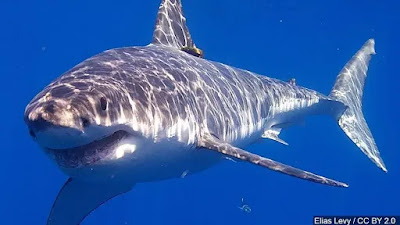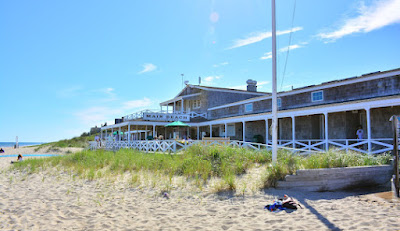When the people of a Long Island resort town abandon themselves to lives of carnal frolic, suburban complacency, and underworld corruption, only a 20-foot Great White shark can set them on the path to righteousness. So goes one reasonable takeaway from this bestseller.
Another would be that this is nothing like the classic movie it would spawn the following summer, though that isn’t so bad a thing. Jaws the novel is just a different kind of fish.
Martin Brody, sheriff of the economically struggling shoreline town of Amity, has two problems. One is a shark that has begun feeding off its population. The other is his community wants the beaches kept open for the tourist money it brings.
As the editor of a local newspaper, the Amity Leader, tells Brody: “If we tell people there’s a killer shark around here, we can kiss the summer good-bye.”
The book opens memorably with a naked young woman, whom we learn later is named Christine Watkins, taking an after-midnight swim in the Atlantic Ocean. While she cuts through water some fifty yards from shore, her scent is picked up by a large creature swimming blind farther out in the black tide. Impulsively, it strikes at the woman.
Peter Benchley’s prose is chilly and masterfully understated, impressive given this was his first novel:
At first, the woman thought she had snagged her leg on a rock or a piece of floating wood. There was no initial pain, only one violent tug on her right leg. She reached down to touch her foot, treading water with her left leg to keep her head up, feeling in the blackness with her left hand. She could not find her foot.
The rest of the attack is brief and final, setting the stakes for all that follows. Once Christine’s remains are recovered, we are thrown into two Brody conflicts, one with the shark and one with the town.
There is a third conflict, one involving infidelity and marital strife, which for a time engulfs the entire book. It may be one of the oddest U-turns ever in a major bestseller, or just Benchley’s attempt to flesh out his pointed social commentary. It distracts from the reason people read Jaws, but also adds to the unease of the reading experience and gives the novel a point of view unique from the movie.
Okay, the movie is better. Much better. But I’m here to tell you the book ain’t bad, just slow and offbeat. If you lived through the 1970s in a suburban beach community, you might even get some flashes of recognition as Benchley’s tale unfolds:
She hated her life, and hated herself for hating it. She thought of a line from a song Billy played on the stereo: “I’d trade all my tomorrows for a single yesterday.” Would she make a deal like that? She wondered. But what good was there in wondering? Yesterdays were gone, spinning ever farther away down a shaft that had no bottom. None of the richness, none of the delight, could ever be retrieved.
That’s an excerpt from the infidelity subplot, which winds up devouring a lot of pages with surprisingly graphic sexual descriptions while contributing nothing to the story about a man-eating shark. This throws many a reader. But re-reading the book suggests it is not as out of place once you consider Benchley wasn’t writing a popcorn thriller but a novel, one less inspired by Lovecraft or Melville than by John Updike.
There’s even a dinner party chapter which portrays the crisis that has become the Brody marriage, Martin acting hot-headed with too much to drink while wife Ellen burns in embarrassment, largely because she wants to impress another party attendee she desires. Some call it soap opera, and it is, but it is also a serio-comic portrait of a marriage on the rocks, with him winding up “alienated” and her humiliated.
“It’s not every night we throw a no-kidding, go-to-hell dinner party,” he fumes.
If there is a main character in Jaws the novel, it is not the shark, who kills three people fairly early on but appears sparingly thereafter. It is not Brody nor his companions in the eventual hunt to kill the shark, Hooper and Quint. It is the town of Amity itself.
While not affluent, dependent as it is on summer tourists, Amity basks in the certitudes of 1970s consumerist America. People measure their lives by the money they make, valuing little else. Sex replaces meaning. The opening chapter features Watkins and her lover rolling in the sand. Later, after she disappears, the man wonders if she slipped into another bedroom for a threesome with the couple sleeping there.
Brody is later told by the town’s mayor, Larry Vaughan, while he frets about covering up the discovery of Watkins’s shredded corpse, that she was “a nobody. She was a drifter. No family, no close friends. She said she had hitchhiked east from Idaho. So she won’t be missed.”
That’s not an atypical comment from the callous politician; you get how he keeps getting elected after meeting his constituents. The town’s oldest resident, Minnie Eldridge, tells all: “We’re being punished for our sins.” Benchley’s prose doesn’t suggest any belief in the supernatural, but one gets a strongly judgmental vibe from him all the same.
There is a lot of shagging in Amity, we come to learn. It seems genetically coded into the population at a young age:
Teenagers lay serried in tight, symmetrical rows, the boys enjoying the sensation of grinding their pelvises into the sand, thinking of pudenda and occasionally stretching their necks to catch a brief glimpse of some, exposed, willingly or not, by girls who lay on their backs with their legs spread.
Ellen personifies this impulse most strongly, and in the process connects the need for sex with the other social subject the book is most concerned with: Class. Ellen wants to validate herself both as a desirable woman in her 30s and as a displaced member of the rich coastal elite who traded down by marrying Martin Brody, a local islander who has an intrinsic dislike for preppie types with their Lacoste alligator shirts.
In the book, she jumps at the chance to assert herself when she meets Matt Hooper, an ichthyologist who comes to Amity to help with the shark problem. He also happens to be the younger brother of a rich boy she once dated: “She wanted an injection, a transfusion of the essence of her past, and she saw Matt Hooper as the only possible donor.”
Ellen doesn’t have to do much to justify this need to herself. If you have seen the movie, and if you have read this far it’s certain you have, you will note this is in stark variance from what happens cinematically. Steven Spielberg’s famous complaint about the novel is that it made him root for the shark; there are decent people like Sheriff Brody, but most of the characters in the book are shockingly base in some way.
The most extreme example of this is the introduction of a mob subplot. Essentially, shutting down Amity triggers some goons to pressure Brody to open the beaches again. They are leaning on Mayor Vaughan, who in turn pressures Sheriff Brody. It gets ugly; even a family cat is killed.
Many readers of Jaws the book call out the Ellen-Hooper fling as Benchley’s major mistake. But the sexual theme may have helped the novel reach the bestseller lists in the months before there ever was a movie. It also feeds a sense of sinners in the hands of an angry god I think Benchley wanted for that added soupçon of doom. Rather, it’s the underworld element that plays more as a contrivance to ramp up the stakes; it is neither well developed nor effectively resolved.
Benchley does much better in other areas. His portrait of Amity throughout the book is deeply immersive and well thought out. There is a lot of detail; maybe too much for those wanting more of the shark. But he fleshes out his fictious community in an intriguing, multi-faceted way, its history of bootlegging and Nazi spies, the local inns, the habits of the local police, even the fate of a couple of unsavory contractors who used cheap green wood on their house jobs. It helps establish the stakes better when the shark endangers people's livelihoods as well as their lives.
A mastery of small details feeds into the shark narrative, too, once the author picks it up. Watching over the shoulder of Quint, the ornery fisherman whom Brody hires to help kill the thing, we see a blue shark get disemboweled, then try to catch the floating morsels leaking from its own body: “The body twitched as the shark swallowed, and pieces of intestines passed out the hole in the belly, to be eaten again.”
Later on, Benchley draws tension setting up the final battle:
The line came clear of the water and hung at the tip of the rod. There was no hook, no bait, no leader. The wire had been neatly severed. Quint hopped down from the flying bridge and looked at it. He felt the end, ran his fingers around the edges of the break, and gazed out over the slick.
“I think we’ve just met your friend,” he said.
Benchley methodically delivers a feeling of what it is like as Quint’s boat makes its date with destiny. The sun beats down, boards creak and the sound of Hooper dropping chum into the sea reminds Brody of diarrhea. When the shark hits, it happens fast with plenty of surprises.
It is a solid finale by itself to a fine book which hardly connects every plot point it throws up but leaves a reader with more to chew on than how much it varies from the film.







No comments:
Post a Comment